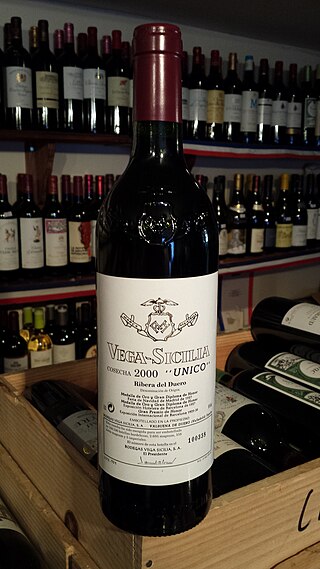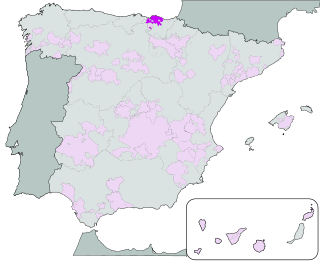
Rioja is a wine region in Spain, with denominación de origen calificada. Rioja wine is made from grapes grown in the autonomous communities of La Rioja and Navarre, and the Basque province of Álava. Rioja is further subdivided into three zones: Rioja Alta, Rioja Oriental and Rioja Alavesa. Many wines have traditionally blended fruit from all three regions, though there is a slow growth in single-zone wines.

Ribera del Duero is a Spanish Denominación de Origen Protegida (DOP) located in the country's northern plateau and is one of eleven 'quality wine' regions within the autonomous community of Castile and León. It is also one of several recognised wine-producing regions to be found along the course of the Duero river.

Bodegas Vega Sicilia is a Spanish winery located in the Ribera del Duero Denominación de Origen in the Province of Valladolid, Castile and León. The winery was founded in 1864 by Don Eloy Lecanda y Chaves, who planted various grapes from the Bordeaux wine region of France, including Cabernet Sauvignon and Merlot, which are still being used in the wines today.

Spanish wine includes red, white, and sparkling wines produced throughout the country. Located on the Iberian Peninsula, Spain has over 1.2 million hectares planted in wine grapes, making it the most widely planted wine-producing nation, but the third largest producer of wine in the world, behind Italy and France and ahead of the United States; this is due, in part, to the very low yields and wide spacing of the old vines planted on the dry soils found in some of the Spanish wine regions. The country is second in wine exports and ninth in worldwide consumption, with Spaniards drinking, on average, 21.6 litres (5.7 US gal) per person a year. The country has an abundance of native grape varieties, with over 400 varieties planted throughout Spain, though 88 percent of the country's wine production is from only 20 grapes — including the reds Tempranillo, Bobal, Garnacha, and Monastrell; the whites Albariño, Airén, Verdejo, Palomino, and Macabeo; and the three Cava grapes Parellada, Xarel·lo, and Macabeo.

Montilla-Moriles is a Spanish Denominación de Origen Protegida (DOP) for wines located in the southern part of the province of Córdoba. It is bounded by the river Genil to the east, by the river Guadajoz to the west, by the river Guadalquivir to the north, and by the Subbetic Range of mountains to the south.

Cigales is a Spanish Denominación de Origen Protegida (DOP) for wines located to the north of Valladolid along both banks of the River Pisuerga.

Toro is a Spanish Denominación de Origen Protegida (DOP) for wines in the province of Zamora, which is in the northwest of Castile and Léon (Spain). The area covered by the DOP is in the southeastern corner of Zamora province and includes the lands known as Tierra del Vino, Valle del Guareña and Tierra de Toro. It borders on the lands known as Tierra del Pan and Tierra de Campos. There are 8,000 ha under vines, of which 5,500 are registered with the DOP Regulatory Council.

Almansa is a Spanish Denominación de Origen Protegida (DOP), known for its red wines, located in the southeast of the province of Albacete, in the transition zone between the high central plateau and the Mediterranean Sea. The vineyards are mostly around the towns of Almansa, Alpera, Bonete, Corral-Rubio, Higueruela, Hoya-Gonzalo, Pétrola and El Villar de Chinchilla.

Méntrida is a Spanish Denominación de Origen Protegida (DOP) for wines covering many municipalities in the northeast corner of the province of Toledo and which is divided into three distinct areas: Talavera, Torrijos and Sagra-Toledo, with over 26,000 hectares under vines, the majority (71%) being in Torrijos.

Valdepeñas is a Spanish Denominación de Origen Protegida (DOP) for wines located in the province of Ciudad Real in the south of Castile-La Mancha (Spain). It is almost completely surrounded by another DOP but is an independent DOP due to its long history of producing a distinct style of wine known aloque or clarete which is made by mixing white and red grapes. 2016´s harvest is formed from 55.9 million kilograms of red grapes and 43.2 million kilograms of white grapes.

Jumilla is a Spanish Denominación de Origen Protegida (DOP) for wines that extends over the north of the region of Murcia, Spain. The area includes the municipality of Jumilla, from which it takes its name, and the contiguous southeast of the Albacete province in the Castile-La Mancha region. It is one of Spain's leading wine regions.

Utiel Requena is a Spanish Denominación de Origen Protegida (DOP) for wines located in the province of Valencia. It takes its name from the two neighbouring towns of Utiel and Requena. It is renowned for the predominant use of the Bobal grape variety.

Pla i Llevant is a Spanish Denominación de Origen Protegida (DOP) for wines located on the island of Majorca, Balearic Islands, Spain. The name in the Catalan or Majorcan language means "plain and east coast."

Verdejo is a variety of wine grape that has long been grown in the Rueda region of Spain. The grape originated in North Africa, and was spread to Rueda in about the 11th Century, possibly by Mozarabs. Verdejo was generally used to make a strongly oxidized, Sherry-like wine.
Dehesa del Carrizal is a Vino de Pago from Spain. This is the highest category on the quality scale of Spanish wines and means that in addition to having a proven track record of consistent quality, the wines have to be both produced from estate-grown grapes and also have to be processed and aged in a winery (bodega) located on the estate.

Arribes is a Spanish Denominación de Origen Protegida (DOP) for wines located in the southeast of the province of Zamora and the northeast of the province of Salamanca, along the border with Portugal on the banks of the River Duero.

Arlanza is a Spanish Denominación de Origen Protegida (DOP) located in the provinces of Burgos and Palencia, Castile and León, Spain. It was officially upgraded from the lower status of QWPSR in 2007. The DOP covers 67 municipalities. There are 23 wineries (bodegas) from Burgos registered and 2 from Palencia. The DOP takes its name from the river Arlanza which flows through it.

Pago de Arínzano is a wine estate that uses the Vino de Pago wine appellation, a classification for Spanish wine applied to individual vineyards or wine estates, unlike the Denominación de Origen Protegida (DOP) or Denominación de Origen Calificada (DOCa) which is applied to an entire wine region. This Vino de Pago is located in the municipality of Aberin, in the Foral Community of Navarra, Spain, and is geographically within the borders of the Navarra DOP. The 300 hectares estate was purchased by the Chivite family in 1988 and was operated by Bodegas Chivite until it was sold in 2015 to a multinational drinks firm, SPI Group.

Txakoli de Bizkaia – Bizkaiko Txakolina is a Spanish Denominación de Origen Protegida (DOP) for wines, located in the province of Bizkaia, Basque Country, Spain. The DOP includes vineyards from 82 different municipalities.

Uclés is a Spanish Denominación de Origen Protegida (DOP) for wines located in the region of Castile-La Mancha, (Spain), around the town of Uclés in the west of the province of Cuenca and in the northeast of the province of Toledo.























